ВУЗ: Казахская Национальная Академия Искусств им. Т. Жургенова
Категория: Книга
Дисциплина: Не указана
Добавлен: 03.02.2019
Просмотров: 17296
Скачиваний: 51
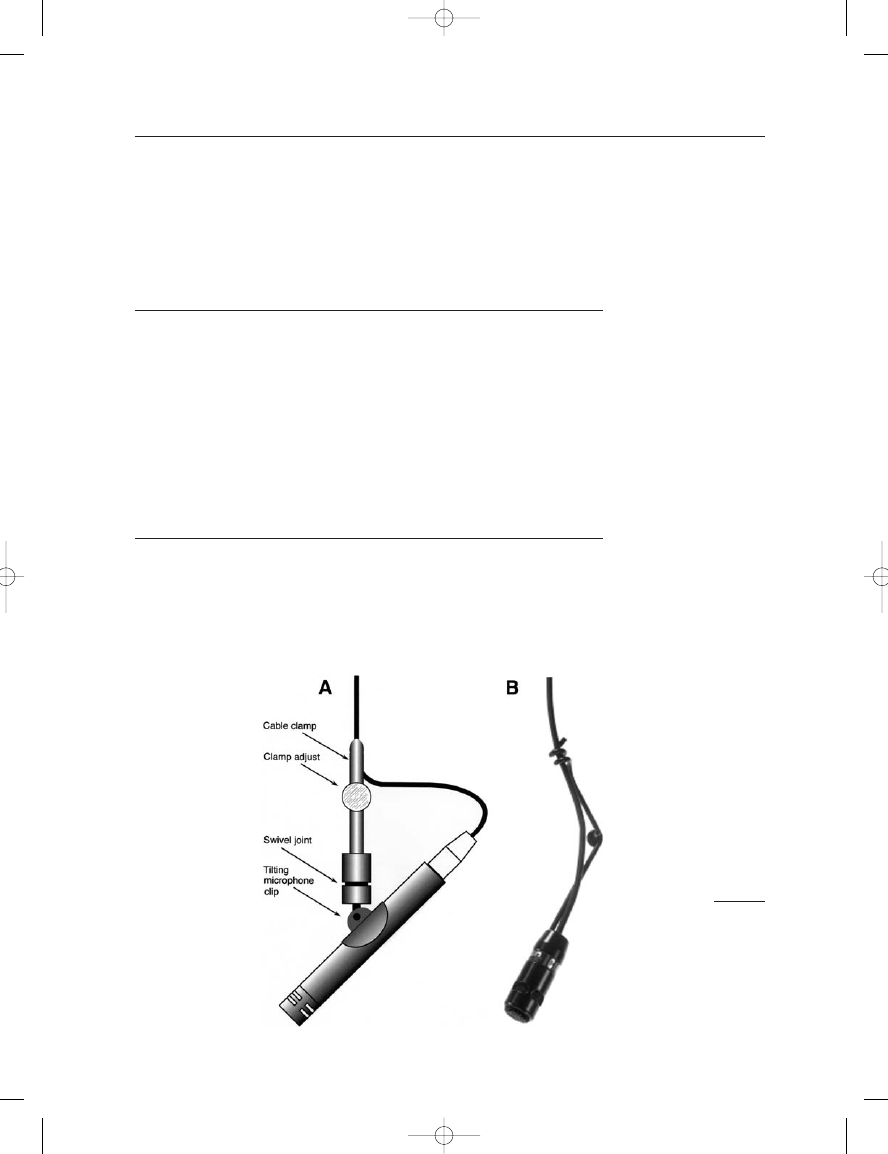
THE MICROPHONE BOOK
158
FIGURE 10–6
Cable mounts; a cable
clamp for swiveling and
tilting of microphone (A);
flexible wire for aiming
small microphone (B).
(Photo B courtesy of Crown
International.)
winch system designed some years ago by the German EMT company.
This figure will give the enterprising designer an idea of the complexity
involved. Such a system as shown here would be useful with a remotely
adjustable stereo microphone and is ideal for use with the Soundfield
microphone.
CABLE MOUNTS
For many performance applications, one or more single hanging micro-
phones may be used with the arrangement shown in Figure 10–6A. This
mount uses a clamping action on the cable, providing a service loop of
cable that permits the microphone to be angled as needed. A horizontal
breast line can be tied to the cable loop for added positioning and mini-
mization of cable twisting over time.
The method shown at B relies on a flexible wire to position a
small electret microphone at the desired angle. An array of such hanging
microphones would be effective for choral pickup in a house of worship.
WIND AND POP SCREENS
The nature of wind noise is shown in Figure 10–7. A puff of wind
travels perhaps 1.5 m/s (5 ft/sec), while sound travels at a speed of
344 m/s (1130 ft/sec). Furthermore, the motion of wind occurs along a
narrow path straight ahead of the talker while speech radiates relatively
uniformly over the forward hemisphere.
Earg_10.qxd 14/9/04 2:48 PM Page 158
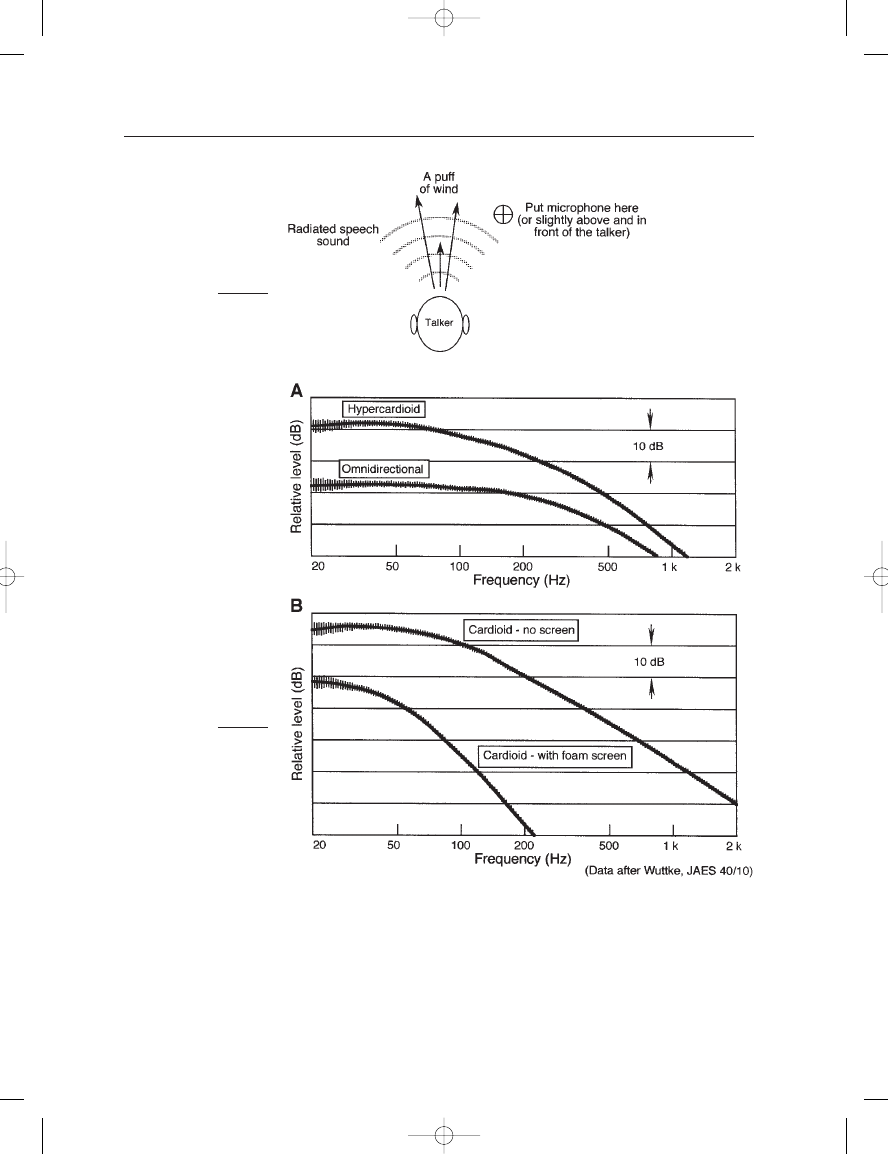
10: Microphone Accessories
159
FIGURE 10–7
Action of wind and speech
on a microphone; the
nature of wind noise.
Most users not familiar with microphones feel that they must talk
directly into the microphone; the important thing is that the microphone
be pointed at their mouth, and that is best done if the microphone is
placed to one side or slightly above the talker along the centerline and
aimed at the talker’s mouth.
Figure 10–8 shows some spectral details of wind noise. For a fixed
wind velocity, the data at A shows that the difference in the noise generated
FIGURE 10–8
Relative effects of wind
on noise generation in
omnidirectional and
hypercardioid microphones
(A); noise generation in a
cardioid microphone with
and without a foam
screen (B). (Data after
Wuttke, 1992.)
Earg_10.qxd 14/9/04 2:48 PM Page 159
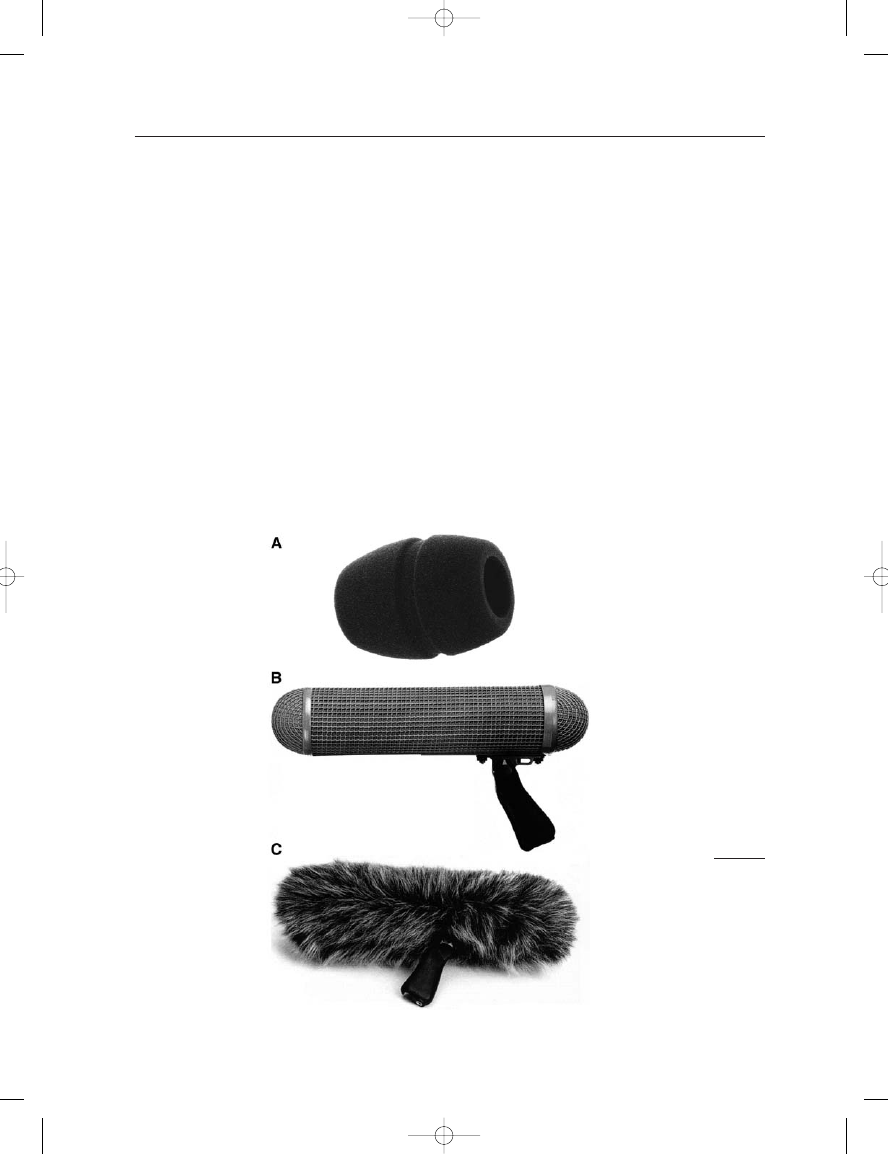
by a hypercardioid microphone is about 20 dB higher than with an
omnidirectional microphone. The data shown at B shows the performance
of a cardioid microphone with and without a foam windscreen. Note that
the effectiveness of the windscreen diminishes at low frequencies. In order
to maintain the high midband reduction in wind noise, the size of the wind
screen has to be increased substantially.
Windscreens can be problematic. They nearly always affect fre-
quency response, and if they are too dense they will affect directionality
as well. Wuttke (1992) points out that any windscreen used with a gra-
dient microphone should have a clear inner open cavity in the region of
the microphone element so that the gradient effect can establish itself
directly at the microphone’s transducing element.
Wind effects do not only occur outdoors. The author has encoun-
tered several concert halls in which high volume velocity, low particle
velocity air handling systems produced wind noise in gradient micro-
phones positioned 3–4 m (10–13 ft) above the floor.
A typical foam windscreen for handheld applications is shown in
Figure 10–9A. An oblong mobile screen is shown at B, and a so-called
THE MICROPHONE BOOK
160
FIGURE 10–9
Windscreens; a typical
foam screen for handheld
or studio use (A); handheld
screen for field use (B);
“furry shroud” for field use
(C). (Photo A courtesy of
AKG Acoustics; Photo B
and C courtesy of
beyerdymamic.)
Earg_10.qxd 14/9/04 2:48 PM Page 160
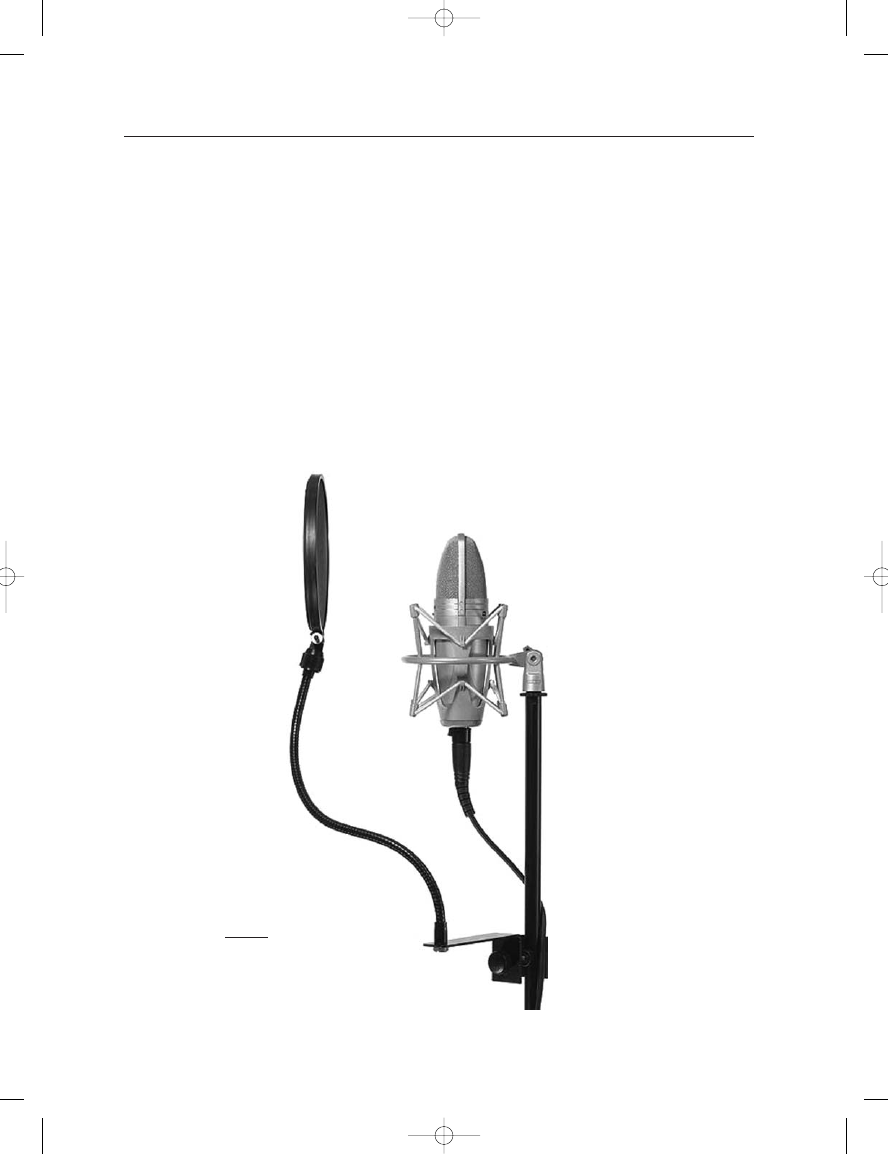
“furry shroud” is shown at C. These assemblies are intended for field use
in television and motion picture recording and are normally used with
rifle microphones mounted on booms or poles.
THE POP SCREEN
A nylon pop screen is shown in typical studio usage in Figure 10–10.
It is a virtually perfect antidote to the “popping” sounds of b and p
from vocalists and announcers in studio applications. It is semitrans-
parent, so that the artist can easily see the microphone, and it has
virtually no attenuation at high frequencies as it effectively disperses
any puff of wind in the direction of the microphone. It is normally
attached to microphone hardware by a small clamp or by a flexible
wire, as shown.
10: Microphone Accessories
161
FIGURE 10–10
A nylon pop screen in
normal operating
position. (Photo
courtesy of Shure Inc.)
Earg_10.qxd 14/9/04 2:48 PM Page 161
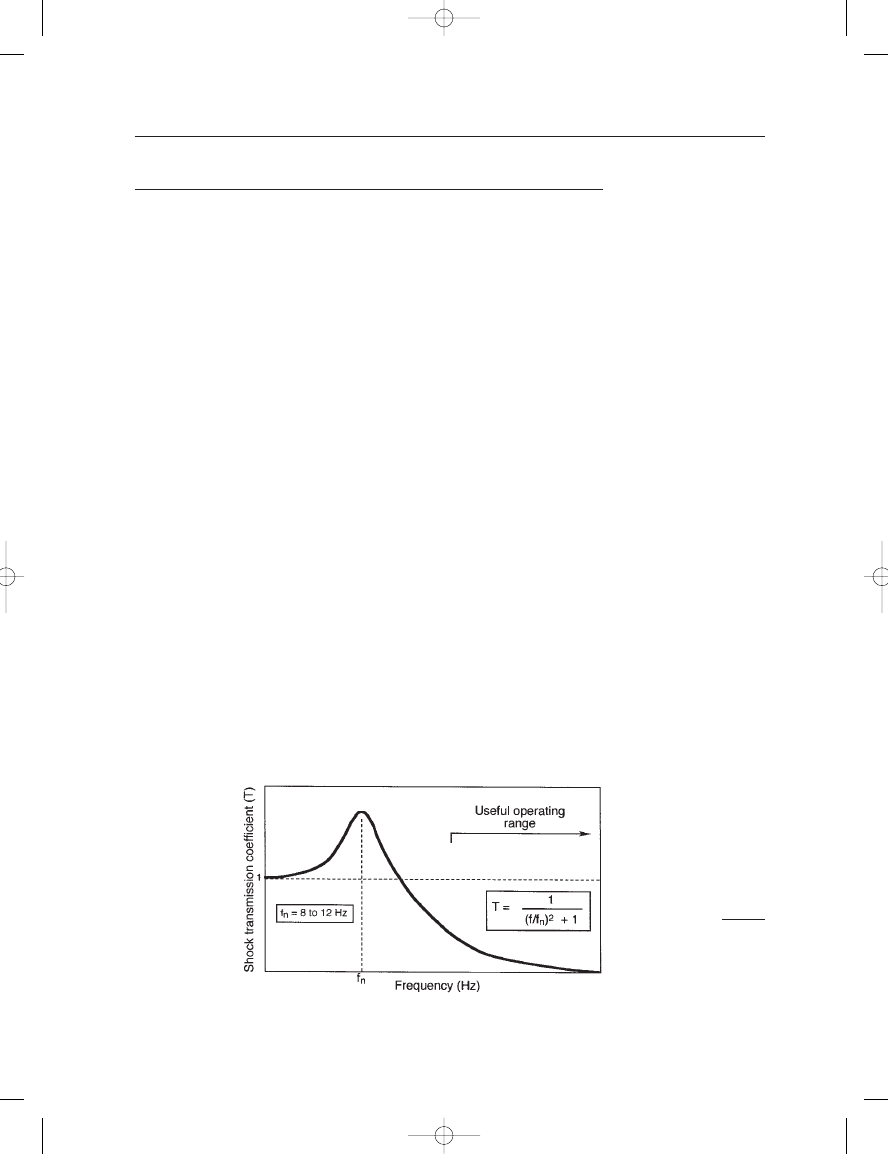
SHOCK MOUNTS
Significant floor vibration transmission through the microphone stand
is not often a problem, but stands may be inadvertently hit by studio
performers. When this occur some form of shock mounting is neces-
sary. Figure 10–11 shows the transmission curve for a typical vibra-
tion isolation system. Note that below the system resonance frequency,
f
n
, the vibration transmission coefficient is constant. Above the reso-
nance frequency the transmission coefficient falls steadily to a low
value. In practice, we would prefer f
n
to be low enough so that negli-
gible audible vibration will be transmitted to the microphone. In order
to do this we need a vibration isolator, commonly called a shock
mount.
A typical assembly is shown in Figure 10–12. A normal isolation
tuning frequency for a large format microphone might be in the 8 to
12 Hz range, well below the normal hearing range. Note that the micro-
phone is entirely suspended by the elastic bands and is not in direct con-
tact with the frame. Note also the microphone cable hanging from the
bottom of the microphone. If for any reason the microphone cable is
pulled taut and fastened to the stand, then the effect of the entire shock
mount may be negated. There should always be a loose service loop of
cable as it exits the microphone, and that loop should be taped to the
microphone stand or boom to avoid any downward gravity loading on
the microphone due to excessive cable length.
Microphones and their shock mounts are designed as a system. It
may be possible to mix and match models to some degree, but if the
resonance varies substantially the effectiveness of the shock mount may
be compromised.
Foam rubber isolating rings are routinely used in microphone
mounts that are sold with microphones. Because of their relatively low
mechanical compliance, these devices account for little in the way of
effective vibration isolation.
THE MICROPHONE BOOK
162
FIGURE 10–11
Universal vibration
transmissibility curve
through a shock mounting
system.
Earg_10.qxd 14/9/04 2:48 PM Page 162